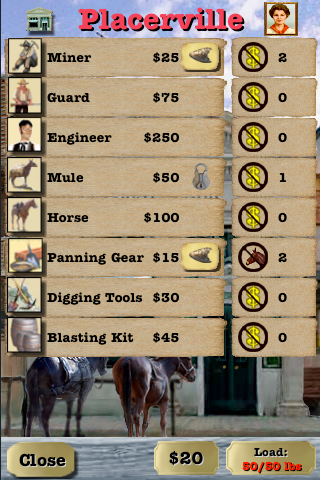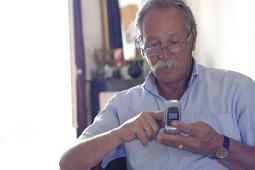Entries in Mobile Engagement Health & Wellness (38)
Humana’s New Mobile Health Applications Are Designed to Engage and Entertain Consumers
 June 22, 2010
June 22, 2010  Have you seen the latest mobile offerings that Humana has brought to the market? Actually, they are in the mobile “health entertainment” space.
Have you seen the latest mobile offerings that Humana has brought to the market? Actually, they are in the mobile “health entertainment” space.
Let me share my conversation with Julie Kling, from Humana's mobile strategy group to shed more light on the direction of their mobile health applications.
Sherri (Stepping Stone Partners):Just last week, Humana launched a new mobile health app called GoldWalker. Why is Humana interested in bringing mobile health applications to the market?
Julie (Humana): Humana is particularly interested in developing mobile health applications that enhance the consumer’s physical and emotional wellbeing.
Our latest mobile health game, GoldWalker, is designed to get people walking and exercising. In fact, my activity level which is measured by an accelerometer embedded in the iPhone moves me through this Gold Mine adventure where I find gold and fend off bandits. GoldWalker connects physical activity with game play.
Sherri: Last month, Humana introduced Hands2gether. What was the thinking behind this mobile health application?
Julie: Hands2gether was created to improve a person’s emotional wellbeing. You simply clap your hand with your iPhone to register your mood. The more you clap, the happier you are on the smile scale. By sending this to a friend, you not only spread happiness but also make yourself feel better.
Sherri: The buzz around most mobile conferences is around “location based services” such as Foursquare. How is Humana considering leveraging these types of mobile services?
Julie: This is an area that Humana is actively exploring. We have an opportunity to offer members incentives to frequent healthy places from restaurants to the gym. We can reward them with health- related prizes as well as the recognition that comes with “badging”. We also believe that people with certain health interests or conditions will want to meet up at a nearby location.
Julie Kling will be speaking at the upcoming World Congress Mobile Health Conference on my “Generating Engagement Through Segmentation, Crowd Sourcing and Personalization” panel. Julie will be presenting examples from Humana in mobile health gaming and care collaboration areas.
Generating Mobile Engagement Through Consumer Segmentation, Crowd Sourcing and Personalization
 June 14, 2010
June 14, 2010  World Congress Leadership Summit on Mobile Health, July 29th & 30th, Boston
World Congress Leadership Summit on Mobile Health, July 29th & 30th, Boston
Healthcare organizations are taking advantage of the consumer’s strong demand for smart phones and mobile health apps. They are piloting new health initiatives through SMS (text), Mobile Web and Mobile Applications and learning about the opportunities and barriers to accelerate adoption and usage.
Industry leaders understand the need to tailor their mobile offerings to specific consumer segments and to personalize the experience to sustain engagement.
During our session, you will learn how our panelists are utilizing mobile to enable care access and compliance, deliver health education as well as influence and track health behaviors. They will show examples of their mobile health initiatives and share insights they’ve gained from segmentation, personalization and crowd sourcing. The panelists will also offer their vision for mobile health opportunities in the near future.
You will gain a unique perspective from companies on this panel which are bringing mobile health offerings to consumers directly as well as through the healthcare delivery and health plan channels. As you will see, each business channel has its own sources of value to engage the consumer.
Facilitator:
Sherri Dorfman, MBA, CEO, Consumer eHealth Engagement Specialist, Stepping Stone Partners
Panelists:
- Bud Flagstad, Vice President, Strategic Initiatives, UnitedHealth Group
- Julie Kling, Mobile Strategy Group, Humana
- Tim Kieschnick, Director, User Experience Internet Services Group, Kaiser Permanente
- Alexandra Pelletier, Team Lead, Program and Product Development, Center for Connected Health, Partners HealthCare System
- Benjamin Rubin, CTO and Co-Founder, Zeo Inc.
Series: Engagement Path #1- Teach Me
 March 31, 2010
March 31, 2010  Most healthcare organizations believe they are effectively providing information to educate consumers about their health. In reality, they are in “broadcast” mode, sending out their communications from many sources in which that are telling “all consumers” about everything.
Most healthcare organizations believe they are effectively providing information to educate consumers about their health. In reality, they are in “broadcast” mode, sending out their communications from many sources in which that are telling “all consumers” about everything.
“They are sending me so many communications and I have such little time to look at them.”
“It is frustrating sorting through all of their health information to find what I need to manage my health”.
“I want sign up to receive certain health alerts on my mobile phone since I am not at my computer very often.”
“Teach Me” Opportunity: Provide a comprehensive yet personalized selection of health education information and tools, that is written at a level that patients can understand, is delivered through online and mobile channels and enables two- way communication.
Engagement in Action:
In order to share different approaches with you, I have selected a few examples which demonstrate how various decision support and social media tools are being utilized to educate the consumer.
- Mayo Clinic has launched their Medical Edge Weekend, online radio show led by specialists discussing selected topics while patients engage through email and twitter to share comments and questions. Mayo also offers “patient friendly” podcasts organized by topics such as “Women’s Health”, “Men’s Health” and “Children’s Health” as well as different conditions.
- American Heart Association has designed the “Profilers” tools to help consumers understand their treatment options. Each question begins with an overview to make sure she is informed before responding. The tool captures personalized information and provides a customized report to share with my doctor for a more in- depth discussion.
- The Eat This Not That tool is designed to teach the consumer about food choices. Consumers are challenged to get the right answer by evaluating the two options placed side by side. With the ticking clock, consumers are rewarded with more points when making the right choice faster. Although the depth of questions in each category (e.g. breakfast, snack, dessert) is not yet available, the tool succeeds in engaging while teaching the consumer about making better food choices.
- CDC has created a FLU IQ Widget which is a tool to test for knowledge for getting and spreading the flu. The widget delivers 10 questions in succession, and gives the correct answer after each one. At the end of the quiz, a final score (out of 10) is displayed along with a message to challenge others which helps spread the learning. This is truly viral!
Each example above offers only a piece of the puzzle. For the full picture, companies need to bring the consumer into the development process and understand their overall need for education from the “outside in”. This insight will help guide the development of a complete solution with new capabilities for communication, collaboration and personalization to “teach” the consumer.
Read about other key engagement drivers:
#2: "Support Me"
#4: "Challenge Me"
#5: "Reward Me"



